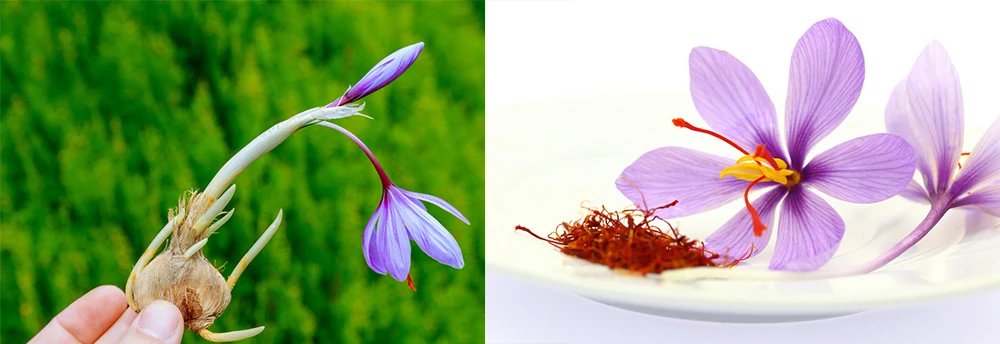The Impact of LED Grow Lights on Indoor Saffron Farming
Saffron, often referred to as “red gold,” is one of the world’s most prized and expensive spices. Harvested from the delicate stigmas of the Crocus sativus flower, saffron has captivated kitchens, medicine cabinets, and luxury circles for millennia.
Traditionally, cultivating saffron has been a labor-intensive process, limited to specific climates and open-field farming. However, with the rise of controlled environment agriculture (CEA), growers can now achieve more consistent yields and higher quality, independent of the weather.
At the core of this agricultural shift is a powerful innovation: LED grow lights.
In this blog, we’ll explore the role of LED grow lights in indoor saffron farming and how to effectively use them to grow saffron in commercial setups.
Saffron’s natural growing requirements
The high cost of saffron is largely due to its labor-intensive cultivation and specific growing requirements. Each saffron thread is the dried stigma of the flower and must be carefully harvested by hand, making the process both time-consuming and delicate.
Saffron thrives in arid regions and follows an annual life cycle. It is primarily grown in countries such as Iran, Kashmir, Spain, and Greece. Although it is an annual plant, farmers typically cultivate it as a perennial by managing the growth of corms (bulb-like structures) for the following season.
A cool, relatively dry winter is essential for the corms to rest and to initiate the development of floral buds for the next year. The ideal temperature range for saffron flowering is between 17°C and 25°C.
As a short-day plant, saffron crocus blooms in the autumn, typically between October and November in the Northern Hemisphere, when daylight hours are decreasing. This shorter day length, combined with longer nights, triggers the plant’s flowering cycle.

How LEDs transform saffron quality and yield
As part of Controlled Environment Agriculture (CEA), LED grow lights play a key role in enhancing corm development, promoting flowering, and increasing overall saffron yield.
According to the Saudi Press Agency (SPA), a team of Saudi researchers successfully shortened the flowering period of saffron to just 10 days by combining vertical farming systems, artificial lighting, and advanced climate control. Traditionally, saffron flowering takes four to six weeks. This innovation significantly improves productivity and makes it possible to grow saffron efficiently in limited spaces.
A similar success story comes from Gujarat, India, where two friends, Subhash Kanetiya and Ashish Bavaliya, began growing saffron in a lab setup in 2023. In their first year, they saw sprouts within 15–20 days and flowers about 50 days later. Their initial harvest cycle lasted around three to four months, resulting in one kilogram of saffron. By 2024, they refined their process and achieved two harvests in a year, doubling their output to two kilograms.
These examples show how CEA and LED grow lights are transforming saffron cultivation, enabling higher yields, better quality, and year-round production, all within compact indoor environments.
How to use LED grow lights for indoor saffron production
LED grow lights are a powerful tool for optimizing indoor saffron cultivation, especially in commercial-scale setups. To effectively use them, three key lighting factors must be considered: spectrum, intensity, and photoperiod.
Light spectrum
Blue light plays a crucial role in enhancing the production of high-quality daughter corms. Research examining the effects of different red-to-blue light ratios (100%, 75%, 50%, 40%, 25%, and 0% blue light) found that increasing blue light levels improves photosynthetic performance and shifts biomass allocation towards corm and flower production [1]. This results in more robust and productive saffron plants.
Another study explored how different LED light qualities affect saffron's growth and photosynthesis [2]. It showed that a 2:1 red-to-blue light ratio promotes the development of elongated leaves, increases chlorophyll content, and enhances photosynthetic activity. This balanced spectrum supports both vegetative growth and flower development.
Beyond the visible PAR range, far-red light also influences saffron quality, particularly crocin production [3]. While far-red light does not significantly affect shoot length or the size and weight of daughter corms, it does impact crocin concentration in the stigmas, which directly affects saffron quality. Incorporating far-red light with a low red/far-red (R/FR) ratio during the dormancy development stage has been shown to support the formation of high-quality corms. These corms are more likely to produce flowers with higher crocin content during the flowering stage.
Light intensity
One of the most critical parameters for flower induction and successful corm development is Daily Light Integral (DLI)—the total amount of photosynthetically active radiation (PAR) received per square meter per day.
According to horticultural lighting research, saffron requires a DLI of at least 15 mol/m²/day to initiate and sustain flowering indoors. This DLI level aligns with the light conditions saffron naturally receives in its native Mediterranean habitats during the fall flowering season. For practical purposes, aiming for a PPFD in the range of 500–550 μmol/m²/s on a 1 m² growing area is recommended.
Photoperiod
While often referred to as a short-day plant, saffron is more accurately described as a facultative short-day plant, meaning it tends to flower more reliably under shorter photoperiods, but does not have a strict critical daylength requirement.
During the pre-flowering and floral induction stages, saffron requires a dark period of approximately 12–14 hours, with a corresponding photoperiod of 10–12 hours of light. These shorter days simulate the autumnal light cycles saffron would experience in its native environment, signaling the corms to break dormancy and initiate flower bud development.
Once floral buds are initiated, increasing the photoperiod to 16–18 hours of light per day can enhance flower emergence and prolong blooming. This extended light exposure supports higher photosynthetic activity, driving energy production for flower formation and sustaining flower longevity.
Sources:
[1] Moradi, Shirin, et al. "Blue Light Improves Photosynthetic Performance and Biomass Partitioning toward Harvestable Organs in Saffron (Crocus sativus L.)." Cells, vol. 10, no. 8, 2021, p. 1994, doi:10.3390/cells10081994.
[2] Zhu, J., et al. "Effect of Different LED-Lighting Quality Conditions on Growth and Photosynthetic Characteristics of Saffron Plants (Crocus sativus L.)." Photosynthetica, vol. 60, no. 4, 2022, pp. 497–507, doi:10.32615/ps.2022.038.
[3] Kajikawa, Nao, et al. "Effect of Far-red Light on Saffron (Crocus sativus L.) Growth and Crocin Yields." Environmental Control in Biology, vol. 56, no. 2, 2018, pp. 51–57, doi:10.2525/ecb.56.51.

